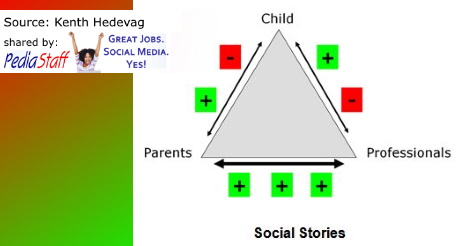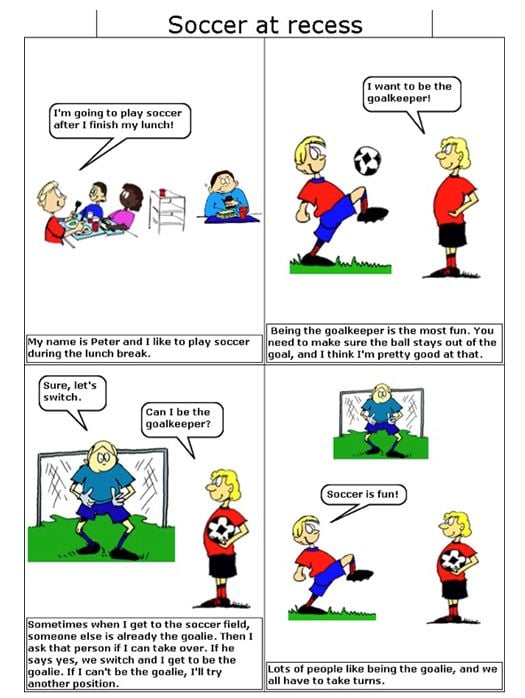Pediatric Therapy Corner: Achieving Effective Joint Communication Through Social Stories

by: Kenth Hedevag
Communication is an exchange of information between at least 2 people. Good communication with the people around us can bring many benefits. You can for example:
- Express what you want.
- Provide information about what you think, feel, or what’s on your mind.
- Get information from others.
- Share experiences with others.
- Benefit social interactions.
Children and teenagers with communication difficulties often need support in their everyday life. The child’s surroundings need to make adjustments to make it easier but it also necessary with support to develop the skills that exist. Us adults often think in a long term perspective and look to what is good for someone in the future, while children and teenagers often think in a more “here and now” perspective. For this reason, it is especially important that professionals and parents make it clear for the child what personal gains can come from everyday communication training. We also know that learning is much easier if the child is experiencing the exercises as enjoyable. We professionals have an important responsibility to also help and support parents who communicate daily with their children.
This simple triangle shows the importance of shared responsibility between children/teenagers, parents and professionals. The relationship between parents and their children and between professionals and children can vary. Sometimes it works well and sometimes it doesn’t. But a necessary condition, one that parents and professionals together are responsible for, is that they together cooperate for the child’s best.

Communicating using visual supports, such as social stories, is a concrete and powerful tool. It’s a tool that can improve social skills and provide a better understanding of social situations.
In order to see the desired results, the visual support needs hold a high standard when it comes to both content and design. If the visual support material describes the situation in a positive manner and includes appropriate suggestions for how to act in that situation, just like a social instruction manual, then it’s a phenomenal tool that can provide great results.
However, if the visual support feels like a reprimand, your chances for success are very limited. Imagine if your boss walked by your desk dropping off a brown envelope containing two pictures; one picture showing your messy desk with a big red cross over it and another picture showing your colleague’s organized desk with a golden star next to it. You would probably not have responded well and thought that your boss could express her opinions in a better way.

Social Stories
Communicating using visual supports, such as social stories, is a concrete and powerful tool. It’s a tool that can improve social skills and provide a better understanding of social situations.
In order to see the desired results, the visual support needs hold a high standard when it comes to both content and design. If the visual support material describes the situation in a positive manner and includes appropriate suggestions for how to act in that situation, just like a social instruction manual, then it’s a phenomenal tool that can provide great results.
However, if the visual support feels like a reprimand, your chances for success are very limited. Imagine if your boss walked by your desk dropping off a brown envelope containing two pictures; one picture showing your messy desk with a big red cross over it and another picture showing your colleague’s organized desk with a golden star next to it. You would probably not have responded well and thought that your boss could express her opinions in a better way.
A social story, designed as a social instruction manual, can be a great tool to support someone with communication difficulties in a problematic social situation.
The following is an example of when a social story became a great tool in a situation where Peter needed support both with expressing himself and understanding other people. Following the example is a short description of how to write a social story.
Peter, who is diagnosed within the autism spectrum, likes to play soccer during his lunch break. Peter struggles with the tactics and is confused about how his teammates want him to play on the field. It’s even harder for him to try to figure out what his opponents think he will do, so that he can do the opposite. When things get too confusing, Peter sometimes lays down on top of the ball so no one can play. I probably don’t have to tell you that this is not very popular among the other players.
After a while, Peter came up with what he thought was a good solution to the problem: He is going to be the goalkeeper! He thinks being a goalkeeper is easier since he knows exactly what he is supposed to do; stop the ball from going into the net, no matter what. He now rushes through lunch so that he can be the first one to arrive at the soccer field and reserve the goalkeeper position.
The problem occurs when someone else is already in goal. Peter sometimes walks up to the person in goal and shoves him or her out of the way, which leads to fights breaking out. This happens several times a week, and both Peter and his classmates are getting sick and tired of the fighting. All they want to do is play soccer.
How can we together solve this problem? We want to work with the group and with Peter individually.
Together with his classmates, an agreement is made where Peter gets to be the goalie more often than the others during the lunch break. His classmates are okay with this solution since they know he has a hard time being a field player. They also know that they can be the goalie during the other breaks, when Peter is doing other things.
For Peter to be able to better understand the situation and to find a more appropriate way for him to handle it, we are going to write a social story. This support first describes the situation in a neutral way and then the feelings that come up in that particular situation. Peter is also given a suggestion for how to act, to make this situation work better for him. At the end of the story, we will tie everything together in a way that he understands. We will walk through the social story together with Peter before he walks over to the soccer field, and an adult will join him the first couple of times.
For Peter and his classmates, this became a good support to handle a social situation that earlier had lead to so many conflicts. We wrote the social story using our software Triple Stories and this is what it looked like:
How To Write A Social Story
Social stories is an educational tool that can be used to clarify social situations. Social stories, a concept introduced by Carol Gray, help you interpret, understand and deal with social interactions between people. The stories are based on specific events or situations, and they are generally written by parents or professionals. Triple Stories uses visual aids, such as images and written dialog, to clearly illustrate situations. A social story can be written in a number of different ways depending on who writes it, the person it was written for, and the situation itself. The most important thing is to create a story that becomes a customized instruction manual, which brings a positive experience to the individual while working as a key to help unlock situations that are difficult to make sense of.
Keep the following in mind when you create your social stories:
- Gather information about the subject in question before you start. What people are involved? The time and the place? What goes on? Why? What happens before and after the process or procedure? Try to see the course of events from the other person’s point of view.
- A first-person narrative is often the best approach; it makes readers feel like they are being addressed personally. Remember to express yourself in simple terms.
- Start with descriptive sentences that provide straightforward information in an objective way and explain the events and the people involved.
- Continue with lines that describe the feelings and reactions connected to the particular situation.
- The next step is to suggest positive alternatives and responses. Focus on the person you are writing for and how they think. The suggestions should be worded in a positive manner, it is important that it doesn’t come off as criticism. The idea is to provide acceptable alternatives for a scenario or situation that may be difficult to grasp or process. Emphasize the best options rather than dwelling on what not to do. Wherever possible, avoid words like never, always and don’t.
- Go for an open and positive approach. For example: “Then I could…” and “I’ll try to…”
- A good conclusion could be a sentence that refers to a logical set of circumstances or an outcome that would be familiar to the person reading the story.
- Introduce the story in a relaxed and positive manner, preferably in close conjunction with the situation or event you would like to illustrate. Afterwards, the story should be kept in an easily accessible place, to be re-read whenever necessary.
Contributing Columnist: Kenth Hedevag
About the author: Kenth Hedevag is a Special Educator, guest lecturer, and speaker at universities and schools. He is the Co-author of Johanna – Tre Diagnoser, a Swedish language book. He currently lectures about girls with Autism and other diagnoses.
PediaStaff is Hiring!
All JobsPediaStaff hires pediatric and school-based professionals nationwide for contract assignments of 2 to 12 months. We also help clinics, hospitals, schools, and home health agencies to find and hire these professionals directly. We work with Speech-Language Pathologists, Occupational and Physical Therapists, School Psychologists, and others in pediatric therapy and education.

